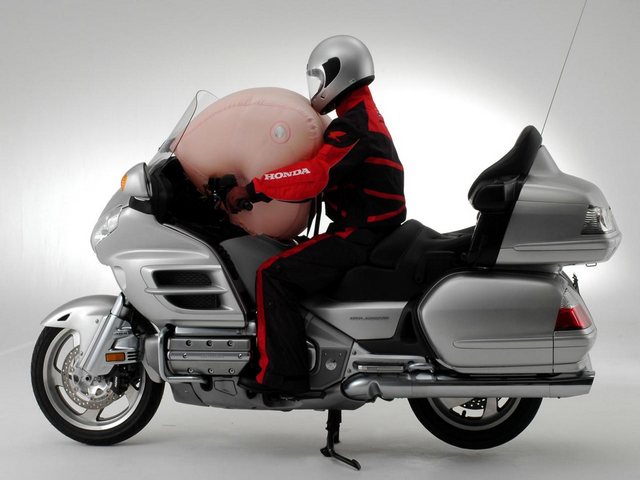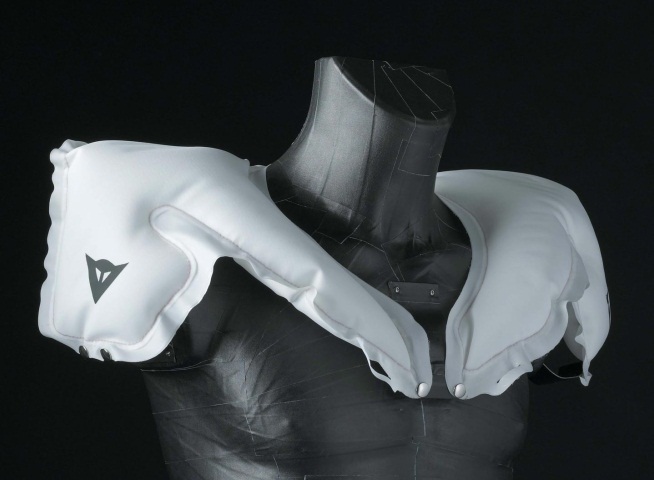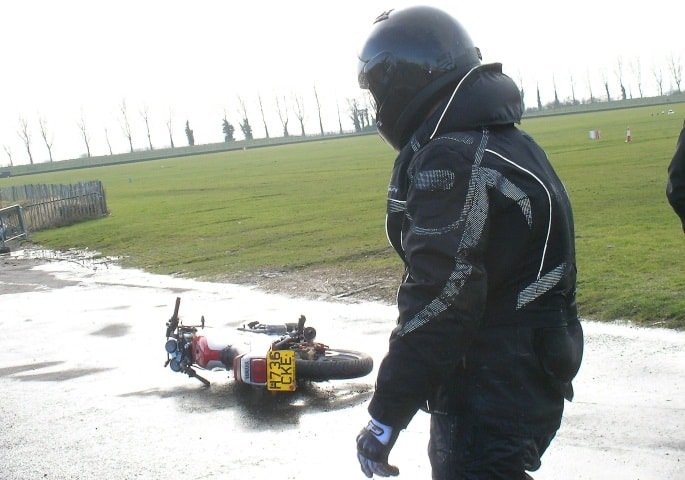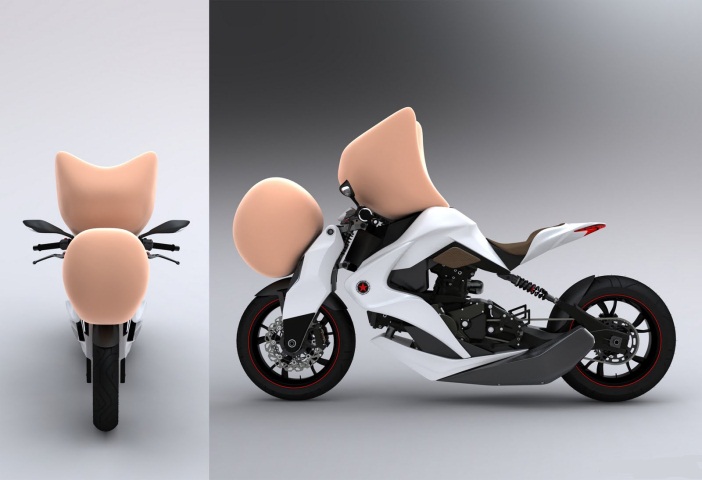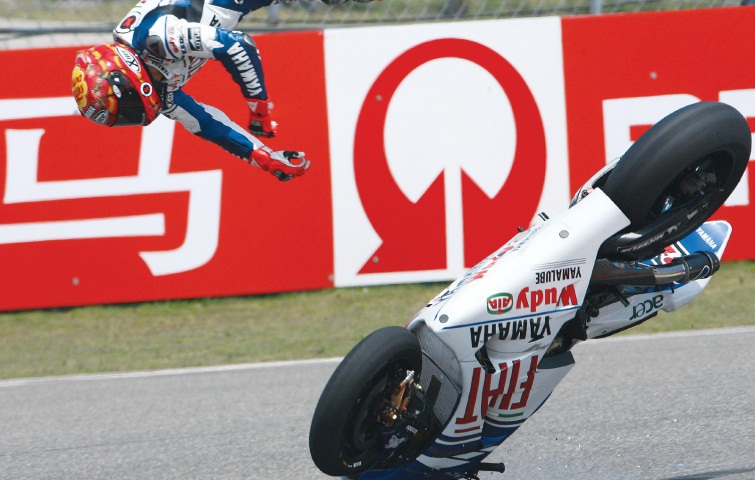Ever since motorcycles were invented, they have been looked at like some of the most dangerous vehicles to be found on the open roads. Despite pretty much anything a rider could say to "defend" this sport, the truth is still unbeatable: motorcycles are a dangerous thing.
We might look 90 or 100 years in the past and we must be true to ourselves: back then the traffic was almost inexistent and still riding a motorbike was nowhere near safe. Today, we've taken speed to a whole new level and the traffic we ride in everyday can't even be compared to that in the early motorcycle history.
With dramatically increased power comes the need for speed and we believe one could hardly find a ride who has never tried to test the limits of his or her bike. Roads may be wider and with way better asphalt, but the number of vehicles and other obstacles has also increased... and unfortunately so have the chances of crashing into them.
Now, the airbag has been a casual presence in our cars for around half a century and in spite of the rather slow start, subsequent design and functionality improvements have finally made airbags much safer and even mandatory. From the initial design of Walter Linderer dating back in 1951, up to the modern airbag systems, the road was long and twisted.
US automotive industry has begun introducing the airbag in mid-seventies, while Europe was still pondering. It was only in the early 80's when Mercedes Benz started to list airbags as an optional equipment for some of its top-notch cars, followed in '87 by Porsche with a 944 turbo, and Audi even later, in mid-nineties.
One might be surprised to learn that motorbike airbags have been tested in the UK during the mid-1970s. Nevertheless, it took about 25 years until the first bike received an airbag unit: the 2006 Honda GoldWing. There is still much debate on the matter, and there are a lot of issues to be considered, when it comes to airbag-equipped motorcycles.
The GoldWing is a huge touring bike, with plenty of room to house numerous gadgets and technology gimmicks. Thanks to the massive dashboard design, Honda engineers can fit a lot of hardware on the bike, no matter whether we're thinking about airbags, sensors, or other types of technology.
What about sport bikes or other kinds of motorcycles in whose design sleek lines, narrow profile and aerodynamics are among the key elements when it comes to performance? It's rather hard to believe that Yamaha would accept a massive redesign of the R1 fuel tank in order to accommodate an airbag unit, provided they'd become fans of such a technology. You don't have to be a bike designer or engineer to figure out that installing an airbag unit is no easy task and major modifications are to be made in order to have both functionality and appeal.
There are skeptics who say that airbag-equipped motorcycles are far from being as safe as advertised and, physics seems to give credit to their opinion, unfortunately. Airbags are meant to inflate in as little time possible, thus cushioning the rider's torso and head and absorb as much as possible from the shock's energy during a crash.
Now, motorbike crash tests have pointed out that the pilots first hit the fuel tank with their pelvic region, then begin moving head-first into the potential obstacle or fly above it (in somewhat lucky scenarios).
The distance between the pilot and the obstacle is usually under 1 meter (roughly 3 feet) and depending on the cruising speed, the body covers this space in a tremendously short amount of time, barely sufficient for the fastest airbag to inflate. Most airbag triggers require a specific G force to deploy; this force is usually caused by the sudden deceleration when the motorcycle hits an obstacle, and is detected by an accelerometer.
By then the rider is usually in full flight towards the car, truck, tree or another person and it's hard to believe that the gas chambers will be inflated in time so that the pilot hits the airbag and not the obstacle, at least not directly. An early crash detection system, if available in the future, could compensate for this simple, yet very serious matter. Until such technology is tested, skeptics claim that the bike-installed airbag is almost useless, save for hitting something at low speed.
With airbags being hard to install on most bikes, the industry came up with another idea: having them inside the very clothing, providing an extra layer of protection in case of a crash. There already are a lot of bike wear manufacturers who offer airbag-loaded jackets and the prices start from around $200. Though some might find that such a jacket is the key to avoiding most bike-related injuries, let's take a closer look at it.
Finding the suitable place to install the inflatable chambers was not that hard: a lot of crash-related data has provided extensive information as of what zones are expected to be hurt when falling off the bike or crashing into an obstacle. With the rider's head being one of the most hazardous parts of the body, a shoulder-mounted inflatable element was a natural choice.
When inflated, the shoulder airbag is meant to limit the head's movement both to either side and backwards, helping reduce the neck injuries. Next comes the back and the ribs: while a broken spine needs no further details in terms of how bad things go, many riders overlook the threat of being hit hard in the ribs.
Aside from the sheer pain of broken ribs or injuries to the respective torso muscles, in case of a violent crash, fractured ribs can penetrate the lungs and even the heart, causing – if not instant death - extensive damage to the internal organs, pneumothorax, internal bleeding and other major complications. Thus, being able to limit the damage to the ribs and side of the body, has indicated the next place to install inflatable airbag elements.
So far so good, one might say; having the rider well cushioned between inflated bags looks like a true life saver. Of course, this might be entirely true if there weren't some other opinions. First of all, we must think about the same timing issue and trigger method.
When it comes to airbag jackets, there are several trigger options. The most common is wiring the CO2 tank to the bike. When the rider gets separated from the motorcycle and if the pull force exceeds a certain value, the gas canister is being opened, inflating the airbag. This triggering method still looks a bit flawed because having the bike pilot already flying towards the obstacle leaves little time for the gas deployment.
If the rider misses the obstacle and is sent flying through the air, a fully inflated airbag system around him/ her might come in really handy when landing back on the road, provided the outer layer of the jacket is not ruptured and the gas bladders remain intact after hitting the asphalt or gravel.
With a time around 0.5 seconds, such an airbag could very well inflate after the impact, though. A car airbag system takes around 170 milliseconds to trigger and this means a third of the time; when riding at high speeds, half a second is usually more than enough to make a very big difference.
Another triggering principle is tethering. It's about two sensors which work on the proximity principle: have them separated and thus severing the connection between them triggers the airbag.
Aside from having to load the sensors and their CPU unit in the very design of the bike, seat and clothes, the tether-triggering method comes with a significant drawback: in most motorcycle crashes, the rider is not separated too far from the bike. Finding the optimal trigger distance has proven yet fruitless; even so, when not hitting an obstacle directly but rather getting thrown off the bike by a lowside or highside crash would give the tether-based airbag system enough time to inflate the bladders.
Finally, there's the multi-sensor triggering; we're most likely looking at the most comprehensive crash detection technology to date, but still far from becoming everyday science. Renowned bike wear manufacturers Dainese and Alpinestars are spearheading the research and it looks like the results they've obtained so far could one day be transposed into mass production goods with affordable prices.
This triggering method involves processing data received from a lot of sensors; with detection units placed on the bike and on the rider, a high-performance dedicated CPU analyzes the data streams and filters the information, trying to determine whether the bike is going to slide out of control or just leaning very closely to the road.
Multiple detection patterns are also used to find out if the vibrations are the result of wobbling past the riders capabilities to maintain further control over the motorbike or are just caused by driving at 200mph over a rougher portion of the track. G-forces, rider posture and body orientation are also taken into account.
Alpinestars' proprietary system even sports a deflation feature and dual nitrogen canisters, allowing the airbags to deploy twice, if needed. This system is so far used in MotoGP racing and it involves 7 sensors and a 5-level trigger-decision routine which takes only 8 milliseconds. So far, we're looking at the most advanced rider airbag rig, but with yet unknown pricing and designed to fit in the aero hump of the racing leather suits.
Motorcycle airbag went a long way and there's still a lot of research to do, while new ideas are sure to follow, and it looks like CPU processing power is one of the key elements. Some might say that the good old bike is getting “too much of a digital whatever“, but the modern traffic/ racing challenges and dangers might find a reasonable solution with it.
With dramatically increased power comes the need for speed and we believe one could hardly find a ride who has never tried to test the limits of his or her bike. Roads may be wider and with way better asphalt, but the number of vehicles and other obstacles has also increased... and unfortunately so have the chances of crashing into them.
Now, the airbag has been a casual presence in our cars for around half a century and in spite of the rather slow start, subsequent design and functionality improvements have finally made airbags much safer and even mandatory. From the initial design of Walter Linderer dating back in 1951, up to the modern airbag systems, the road was long and twisted.
US automotive industry has begun introducing the airbag in mid-seventies, while Europe was still pondering. It was only in the early 80's when Mercedes Benz started to list airbags as an optional equipment for some of its top-notch cars, followed in '87 by Porsche with a 944 turbo, and Audi even later, in mid-nineties.
One might be surprised to learn that motorbike airbags have been tested in the UK during the mid-1970s. Nevertheless, it took about 25 years until the first bike received an airbag unit: the 2006 Honda GoldWing. There is still much debate on the matter, and there are a lot of issues to be considered, when it comes to airbag-equipped motorcycles.
The GoldWing is a huge touring bike, with plenty of room to house numerous gadgets and technology gimmicks. Thanks to the massive dashboard design, Honda engineers can fit a lot of hardware on the bike, no matter whether we're thinking about airbags, sensors, or other types of technology.
What about sport bikes or other kinds of motorcycles in whose design sleek lines, narrow profile and aerodynamics are among the key elements when it comes to performance? It's rather hard to believe that Yamaha would accept a massive redesign of the R1 fuel tank in order to accommodate an airbag unit, provided they'd become fans of such a technology. You don't have to be a bike designer or engineer to figure out that installing an airbag unit is no easy task and major modifications are to be made in order to have both functionality and appeal.
There are skeptics who say that airbag-equipped motorcycles are far from being as safe as advertised and, physics seems to give credit to their opinion, unfortunately. Airbags are meant to inflate in as little time possible, thus cushioning the rider's torso and head and absorb as much as possible from the shock's energy during a crash.
Now, motorbike crash tests have pointed out that the pilots first hit the fuel tank with their pelvic region, then begin moving head-first into the potential obstacle or fly above it (in somewhat lucky scenarios).
The distance between the pilot and the obstacle is usually under 1 meter (roughly 3 feet) and depending on the cruising speed, the body covers this space in a tremendously short amount of time, barely sufficient for the fastest airbag to inflate. Most airbag triggers require a specific G force to deploy; this force is usually caused by the sudden deceleration when the motorcycle hits an obstacle, and is detected by an accelerometer.
By then the rider is usually in full flight towards the car, truck, tree or another person and it's hard to believe that the gas chambers will be inflated in time so that the pilot hits the airbag and not the obstacle, at least not directly. An early crash detection system, if available in the future, could compensate for this simple, yet very serious matter. Until such technology is tested, skeptics claim that the bike-installed airbag is almost useless, save for hitting something at low speed.
With airbags being hard to install on most bikes, the industry came up with another idea: having them inside the very clothing, providing an extra layer of protection in case of a crash. There already are a lot of bike wear manufacturers who offer airbag-loaded jackets and the prices start from around $200. Though some might find that such a jacket is the key to avoiding most bike-related injuries, let's take a closer look at it.
Finding the suitable place to install the inflatable chambers was not that hard: a lot of crash-related data has provided extensive information as of what zones are expected to be hurt when falling off the bike or crashing into an obstacle. With the rider's head being one of the most hazardous parts of the body, a shoulder-mounted inflatable element was a natural choice.
When inflated, the shoulder airbag is meant to limit the head's movement both to either side and backwards, helping reduce the neck injuries. Next comes the back and the ribs: while a broken spine needs no further details in terms of how bad things go, many riders overlook the threat of being hit hard in the ribs.
Aside from the sheer pain of broken ribs or injuries to the respective torso muscles, in case of a violent crash, fractured ribs can penetrate the lungs and even the heart, causing – if not instant death - extensive damage to the internal organs, pneumothorax, internal bleeding and other major complications. Thus, being able to limit the damage to the ribs and side of the body, has indicated the next place to install inflatable airbag elements.
So far so good, one might say; having the rider well cushioned between inflated bags looks like a true life saver. Of course, this might be entirely true if there weren't some other opinions. First of all, we must think about the same timing issue and trigger method.
When it comes to airbag jackets, there are several trigger options. The most common is wiring the CO2 tank to the bike. When the rider gets separated from the motorcycle and if the pull force exceeds a certain value, the gas canister is being opened, inflating the airbag. This triggering method still looks a bit flawed because having the bike pilot already flying towards the obstacle leaves little time for the gas deployment.
If the rider misses the obstacle and is sent flying through the air, a fully inflated airbag system around him/ her might come in really handy when landing back on the road, provided the outer layer of the jacket is not ruptured and the gas bladders remain intact after hitting the asphalt or gravel.
With a time around 0.5 seconds, such an airbag could very well inflate after the impact, though. A car airbag system takes around 170 milliseconds to trigger and this means a third of the time; when riding at high speeds, half a second is usually more than enough to make a very big difference.
Another triggering principle is tethering. It's about two sensors which work on the proximity principle: have them separated and thus severing the connection between them triggers the airbag.
Aside from having to load the sensors and their CPU unit in the very design of the bike, seat and clothes, the tether-triggering method comes with a significant drawback: in most motorcycle crashes, the rider is not separated too far from the bike. Finding the optimal trigger distance has proven yet fruitless; even so, when not hitting an obstacle directly but rather getting thrown off the bike by a lowside or highside crash would give the tether-based airbag system enough time to inflate the bladders.
Finally, there's the multi-sensor triggering; we're most likely looking at the most comprehensive crash detection technology to date, but still far from becoming everyday science. Renowned bike wear manufacturers Dainese and Alpinestars are spearheading the research and it looks like the results they've obtained so far could one day be transposed into mass production goods with affordable prices.
This triggering method involves processing data received from a lot of sensors; with detection units placed on the bike and on the rider, a high-performance dedicated CPU analyzes the data streams and filters the information, trying to determine whether the bike is going to slide out of control or just leaning very closely to the road.
Multiple detection patterns are also used to find out if the vibrations are the result of wobbling past the riders capabilities to maintain further control over the motorbike or are just caused by driving at 200mph over a rougher portion of the track. G-forces, rider posture and body orientation are also taken into account.
Alpinestars' proprietary system even sports a deflation feature and dual nitrogen canisters, allowing the airbags to deploy twice, if needed. This system is so far used in MotoGP racing and it involves 7 sensors and a 5-level trigger-decision routine which takes only 8 milliseconds. So far, we're looking at the most advanced rider airbag rig, but with yet unknown pricing and designed to fit in the aero hump of the racing leather suits.
Motorcycle airbag went a long way and there's still a lot of research to do, while new ideas are sure to follow, and it looks like CPU processing power is one of the key elements. Some might say that the good old bike is getting “too much of a digital whatever“, but the modern traffic/ racing challenges and dangers might find a reasonable solution with it.
